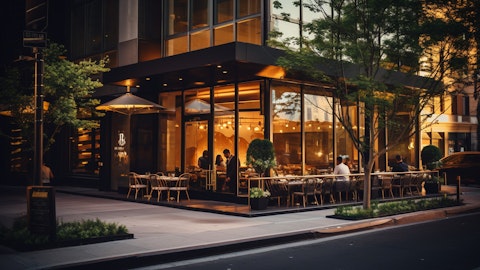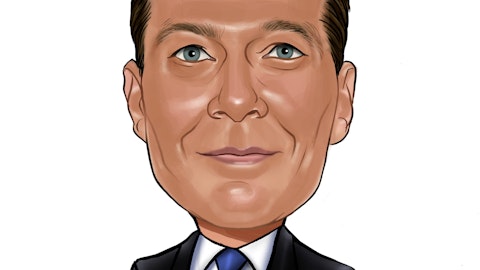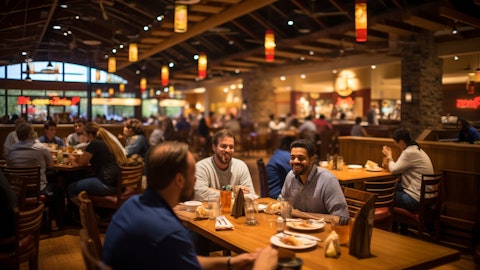Chris Meyer: Well, yes, and so, the convert gets pretty complicated. But let me — so let me just try to frame the 300, because it’s an important part of what we’re trying to do here, the $350 million share repurchase authorization. So you can put aside the $150 million, right? Because the $150 million is just normal course of business. We did $70 million of share repurchases in 2023. We got another $150 million for the next 18 months. That’s pretty much normal course of business. The remaining $200 million, it just gives us optionality. And again, I’m not going to get too much into timing, because timing could be anywhere between now and next May when the convert comes to maturity. But what I can say about how it would be performed is, at the end of the day, what would likely be the outcome is that you would have — of that $200 million of share repurchases, you would just have the 4 million shares that are currently sitting in my adjusted earnings per share count.
Those shares would come out of the share count, using the funds from the $200 million. The remainder of it, the $105 million that’s the principal on the convert, there’s just some options between I can do some share buybacks and issuing shares, et cetera. There’s just some arbitrage there, that’s really more just a refinancing kind of event. The real impact to share count would be that 4 million shares that are sitting currently in my adjusted share count, if that makes sense.
Sharon Zackfia: Great. Thank you very much. Very helpful.
Operator: Thank you. Our next question comes from the line of Brian Harbour with Morgan Stanley. Please proceed with your question.
Brian Harbour: Thanks. Good morning. Yes, and Chris, best of luck to you. Just a question on, did you spell out what you expect wage inflation to be this year? And I think the broader question about labor, do you feel like there’s kind of a need to reinvest in labor or add some to stores as you think about kind of building traffic this year.
David Deno: Yes. I think our labor models are very well established, well run. We’ve invested behind the technology to enable our servers. We’ve invested in cooking technology to enable our back of the house. The service model is strong, and we feel very good about it. So the labor spending at the restaurant level, number of hours, et cetera, is in really good shape.
Chris Meyer: And you asked about inflation. Look, yes, I mean, I think that — yes, I think inflation, call it 4.5%, it just seems like that 4% to 5% range of inflation is just pretty sticky. And I don’t see it going anywhere anytime in the future, particularly since we have such a presence in Florida, and Florida is going through this stage of raising their minimum wage. So, look, I think that just part of how we go to market, that’s why the productivity initiatives and things like that become so important, because you need some offsets. You can’t just take unlimited amounts of pricing to offset that. And that’s why we focus so much on making sure we do the right thing with productivity.
Brian Harbour: Okay. Yes, got it. Thanks. Maybe I’ll take the bet on your comment about kind of the work you’ve done here at customer. What’s changed, I guess, or what was some of your key insights from that work you’ve done?
David Deno: Yes, I don’t want to get into too much detail for competitive reasons, but a couple of things. One, our core is loves Outback Steakhouse, and they continue to say that again and again and again. And I think we have some permission from some of our explorers out there that might be looking at some other categories of interest, but the focus is on the core. And if we can pick a few explorers that look at other categories besides steak, I think Outback has the permission to do that. And the last thing is, the reinforcement of how Outback is such an adventurous steakhouse. And we have a lot of support for our long heritage of No Rules, Just Right, our Aussie heritage, et cetera, all those things came to light, as we continue to do our research.
Operator: Thank you. Our next question comes from the line of Lauren Silberman with Deutsche Bank. Please proceed with your question.
Lauren Silberman: Hi. Thank you. On advertising, so I want to ask a bit more there and your approach to marketing. What type of messaging are you going to lean into 2024? How much more in value do we need to see? And then just in terms of how we think about the step up in advertising spend?
David Deno: Yes, it will move up during the year, but I think more importantly, it’ll do — it’ll be with ideas that we have, which I’m — like I said before, I’m very optimistic about. I think if we can do the combo of products that consumers really love, and I don’t want to get into detail here along with a good value, I think that’s the magic that we can bring together at Outback, especially to help grow traffic in our advertising and our consumer awareness and excitement. I think that’s clearly something that we can do because we have a heritage of that. The second thing is, like I said, you’ll see the step-up of spending during the year, as the ideas come to fruition. And we’ll continue to track that return as we go forward.
And lastly, I think we have a much better understand, we talked about on other calls on, the way to advertise, be it digital versus network, versus television, those are things that we can also look at and change the mix around as we need to. So those are the things that we’re doing with our advertising investment, and we continue to track the returns and what we can do going forward.
Lauren Silberman: Okay, thank you. And then just on restaurant margin, what’s embedded in the guide this year? And can you just talk about, how we should be thinking about the cadence of margin throughout the year? Thank you.
Chris Meyer: Yes, I think as you look at — we’ll start with operating margins and we’ll talk about restaurant margins at the same time. I think — but to give perspective, we finished at 7.6% in our op margin line in 2023. 50 basis points of that was driven by the 53rd week and the Brazil tax exemption. So you’re not going to have those in 2024. So if you exclude those two and you say your starting point is 7.1%. Look, with the guide we gave, I’d expect op margin to be slightly up to slightly down, probably flattish, depending on where we land within our guidance range, in and around, call it 7% or so, which is, again, as a reminder, it’s 210 basis points above where we were in 2019, despite what continues to be very persistent inflation.
So you think about it from a restaurant margin and a category perspective, I think cost of goods sold and OpEx, just given where the productivity dollars will probably land and some of the inflation that we’re seeing in those categories, COGS is a little bit less inflation this year. Both those categories have a decent chance to be favorable in terms of margin year-over-year. Labor is probably the one category that’s most likely to be a little higher year-over-year, given the inflation that I just talked about, that 4% to 5% inflation. And then the other piece is, when you go further down the P&L, the one G&A, we’d like to keep somewhat flat on a dollar basis, but depreciation is going to be higher obviously with the capital spend. So I would expect depreciation as a percentage of total revenues to be higher as well.
So that gives you a little bit of sense of how I think about the pieces part.
Lauren Silberman: Thank you. Very helpful.
Operator: Thank you. Our next question comes from line of Brian Vaccaro with Raymond James. Please proceed with your question.
Brian Vaccaro: Hi, thanks and good morning and congrats, Chris. Best of luck to you. So I’m just circling back on the Outback comps for a second. Could you be a little more specific on the degree of improvement you’ve seen or how much that spread versus the industry has improved over the last few months? And also just given the unusual swings on weather in January, any way you could level set how your U.S. comps look more recently as the weather has normalized?
David Deno: Yes, I don’t want to get into specific percentage points versus the industry, Brian, I hope you understand that. But I think you know me pretty well. We’ve gone from a place, especially in the fall when Outback was behind the industry in same store sales growth to a point in December, and then into Q1, where we’re consistently ahead. And we’re very pleased about that. And that’s the result of the beginning of the work we’re doing. And we can see going forward some of the work we’re doing to help that trend continue and hopefully strengthen. But that is about all I can say right now. I don’t want to get into price points per se. After the weather the first three weeks, we’ve seen the trend resume that we saw in December, and the last few weeks have shown just that. And so we tried to bundle all that into our guidance for the quarter.
Brian Vaccaro: Okay, fair enough. And on that spread, is it fair to say that that spread is positive on both a comp and traffic basis?
David Deno: Yes.
Brian Vaccaro: Okay.
David Deno: Brian, before I get your next question, I just want to mention one thing that hasn’t gotten a lot of attention on this call, but I just need to say a couple of things about the Carrabba’s team, how great they’re doing. And if you look at their trends versus the industry, they’re just knocking it out of the park, both in traffic and in sales. And it’s a brand we feel very good about and something that has investment opportunities going forward. So excuse me for interrupting you, but I just wanted to mention that.
Brian Vaccaro: No, absolutely, and definitely noted. My other question was just on the fourth quarter store margin dynamics, labor and other OpEx moved a little differently than we were expecting. And I guess on labor, that’s little over 100 basis points of pressure I think you saw year-on-year. Could you just give some color on what drove that and to what degree you reinvested in hours or service in the quarter?
Chris Meyer: Yes, well, I wouldn’t say so much reinvestment in hours for service. I think the labor dynamic that you see in Q4 was mostly inflation, but we did have some additional compensation expenses relative to last year, specifically related to the 53rd week. As we pay our partners on a percentage of cash flow that 53rd week was just outsized and it’s just — we just lost some leverage on that line. And we were lapping some stuff from a year ago from one time perspective, that wasn’t as big, but those are kind of the big buckets. I mean, I think that, broadly speaking, Brian, the Q4 margin performance, what we really try to tune people into was the fact that the COGS line was going to move the way that it did, because we had been leveraging that restaurant margin pretty favorably up until Q4.
But we talked about the idea that we weren’t going to leverage the COGS line just because some of the beef activity that we had a year ago. So that was probably the biggest dynamic. But yes, labor was a little higher but I think it had a lot to do with just kind of the dynamics of the 53rd week and how that came together.
Brian Vaccaro: Okay. Thank you for that. And just on the topic of productivity, if I could last one, what level of savings did you achieve in ’23? And could provide a few more specifics on what some of the key drivers of efficiency in 2024 will be?
Chris Meyer: Yes. So we ended up at about $55 million or so of productivity in 2023. And again, I think the buckets that we saw in 2023 are largely going to be the buckets that we would see in 2024. Again, I think we’re going after another $50 million of productivity this year. A lot of it is going to be driven by the restaurant technology that we put in place. But another big piece is going to be supply chain related, because there’s a lot of opportunities there that we’ve been looking at, as well as some of the menu work and things that Dave talked about. So it’s going to be pretty broadly spread across the P&L between COGS and labor, et cetera, again, maybe a little more weighted to cost of goods sold, but we’ll see.
David Deno: I just want to underscore to Brian. The productivity we do will not touch food quality and not touch service levels. It’s pure getting our great products and our service to our people in a more efficient manner. So that’s extremely important to us.
Brian Vaccaro: All right. Thank you very much. I’ll pass it along.
Operator: Thank you. Our next question comes from the line of Brian Mullan with Piper Sandler. Please proceed with your question.
Brian Mullan: Thank you. Just a question on Brazil, can you just touch on the operating environment down there right now? What you expect to see as you put together the guidance for the year? And then just related to that, I know you’ve been asked this many times in the past, but if you could just give your current thinking on your desire to own those restaurants longer term, and if the current environment is conducive to taking any action on that front for the foreseeable future?
David Deno: Sure, the environment remains good. Inflation has come down. Interest rates are still pretty high down there, but the consumer is in good shape. We had a tremendous sales improvement last year at this time, probably because of the World Cup. So that was a very difficult lap, which we were able to do. And so the new openings are fantastic. Our position is unparalleled, number one. And so the operating environment, we believe, continues to be really, really strong. So that is — that’s important. The second piece is, we’ve looked at in the past about potentially having that business to be a franchise business. That still is something that we may or may not consider. We’ll just continue to look at the environment and then the value we get from the business, and as we move forward. So we continue to look at optionality down there. But right now, our job is to continue to build a great business.
Brian Mullan: Okay, thank you. And then just as a follow-up, just a question on Bonefish. May be — can you touch on some of the same store sales trends recently? Maybe what’s going on with that brand? What are the key priorities for that brand this year over the next few years? Just what’s the team going to be focused on?



